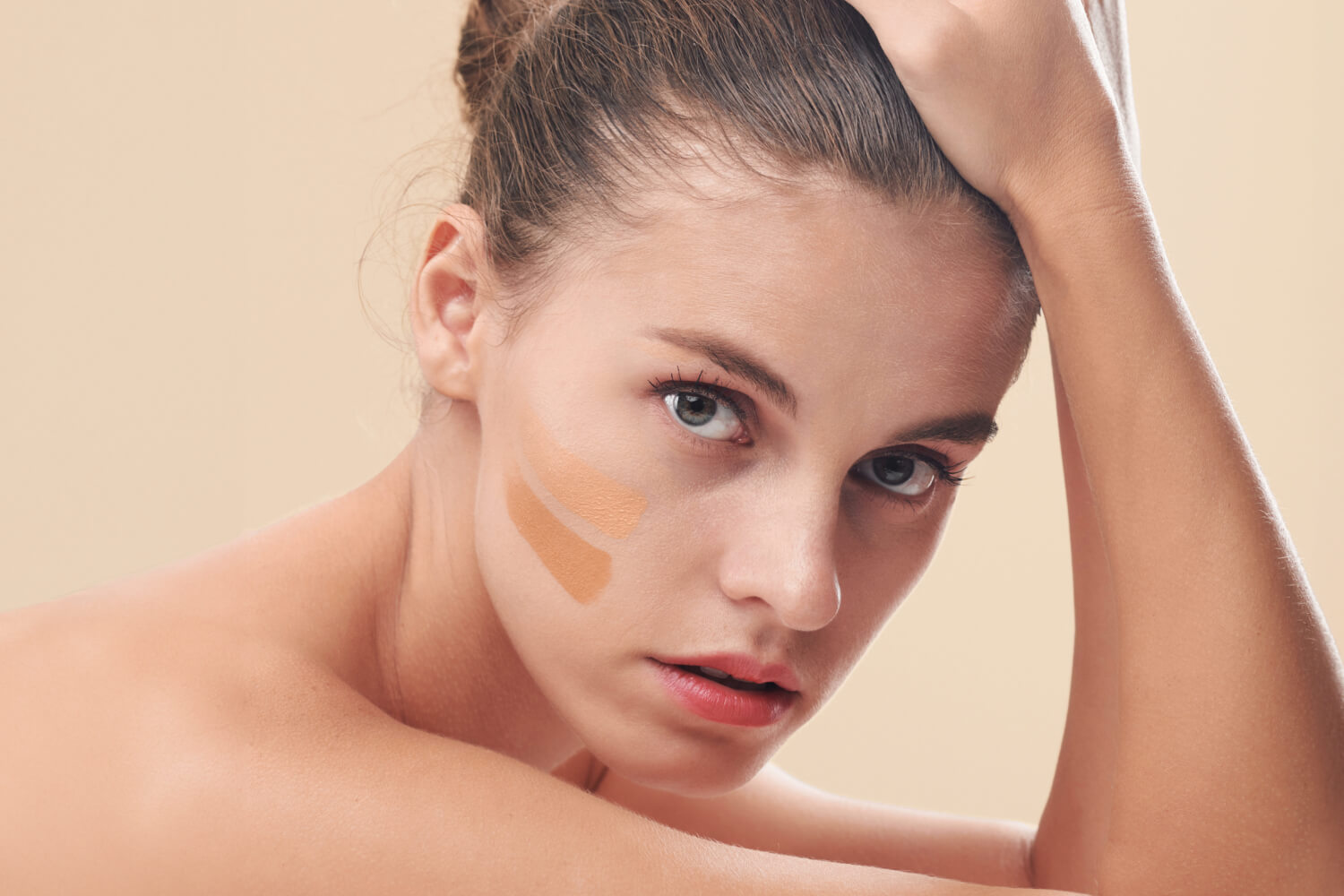
Even though foundation is a basic makeup product, it plays an important role in the final result of your makeup look. When you find the perfect foundation shade and texture, it smooths flaws, naturally evens out the skin and wears comfortably. Your skin looks just like your skin, and imperfections fade away like magic. There’s just one problem: how do you choose the right foundation?
In order to find the ideal foundation for you, there are a number of features that must be considered. To begin with, obviously the shade. But you should also pay special attention to consistency, protection against external factors, coverage, durability and any eventual skin benefits. We understand how challenging this might be, especially online. After reading this, you’ll be more than ready to go and find the perfect foundation shade and texture for your skin.
On this post:
- Step One: Pick your formula & texture
- Step Two: Find the right foundation shade
- Step Three: Test wisely
Step One: Pick your formula & texture
Before scrolling the available shade range, you’ll need to choose the perfect foundation range for your skin needs and preferences. In order to do so, you need to know how to answer one incredibly important question: what is your skin type?
Just as important, you must also define your favorite finish, from matte to glowy.
How to match your foundation to your skin type
If you have dry skin, the best foundations are those moisturizing and even nourishing. You may find those in all formats, but more often than not they come in liquid or cream presentation. Combination and oily skin types may find their perfect match in oil-free, lightweight formulas that can come in powder or liquid textures.
If you struggle with any specific skin condition, such as sensitive skin, acne or rosacea, you also might want to remember it when choosing a foundation. For sensitive skin, you’re safer with unscented products, while acne-prone skin should probably avoid products that promise to create a glowy, shiny complexion.
Types of foundation coverage
Coverage is very important when you’re trying to choose the right foundation for you. Would you like something lightweight and subtle? Then look for some sheer to medium coverage foundation. They’ll have enough coverage for small imperfections you may want to conceal.
If you’re a fan of a full face of makeup with airbrushed skin, then go for full coverage formulations. To conceal some extra demanding imperfections, or even tattoos, we recommend you choose a foundation of your liking and rely on concealer and/or correctors to deliver greater coverage where it’s needed. For this purpose, a concealer like the Makeup Revolution Conceal & Define Concealer may be a good option. As extremely high coverage products tend to have more pigment and texture, they also tend to highlight wrinkles and uneven texture. If that’s not the result you’re looking for, then add some correcting product after the foundation and your skin will look flawless!
Foundation with skincare benefits: What’s that all about?
Now it’s time to look at other benefits that your foundation may offer. Would you like your foundation to have SPF? Then take a look at the Shiseido Sports HydroBB Compact SPF50+. For a rejuvenating action, check the Sensilis Upgrade [Make-Up] Lift Effect Cream. It might or might not be a deal-breaker for you, but check for some other benefits that may enhance your skin as well as the results of your everyday makeup.
Step Two: Find the right foundation shade
If you’ve already determined your skin type, ideal foundation coverage, as well as any additional foundation benefits, you’ve probably narrowed down your options to one range of foundation. Now it’s time to help you find your perfect shade. You’ll need to know two things in order to procedd: your skin tone (aka the “depth” of your skin color) and your skin undertone.
Skin color depth: Light vs Dark
This variable is going to define how light or dark the perfect foundation for you is. Most of the foundations are described in such shade range as fair, light, light-medium, medium-dark, dark or very dark. Foundation color names may vary, but the important thing to do is to define which shade would fit your skin tone the best.
If you’re unsure, try to check some YouTubers or bloggers with a skin tone similar to yours. At the same time, you should search for online photos and swatches that show how the foundation looks on someone with your skin tone.
If you already own a foundation you love, you can use online tools like Findation to help you find color matches across different products and brands. All you need to do is enter the brand, range, and tone of a foundation or concealer you already know and love; Findation will find you multiple color-matched recommendations, and you can from there! If you like, you can also use the tool to find matches across specific products. Say you use a BB cream from Missha and want to find a concealer from Catrice that matches it; Findation can do that for you!
Skin color undertone: Warm vs Cool
It is very important to choose the perfect undertone. You may find a color that is the right amount of light or dark for you, but if it is too pink or yellow, that won’t work. In most cases, it is easy to judge whether we are a warm or cold type of beauty.
The main principle is that we look good in colors that harmonize with our color tone. For example, if your skin’s undertone is cool, you should go for a foundation with a cool tone. It will emphasize your beauty and create a harmonious final look. You can choose foundations with cool, warm, olive, or neutral undertones to match your skin undertone.
We have a few tips to help you determine your undertone based on how light or dark your skin is:
- If you have light skin, check your wrists. If you have a cool undertone, then the veins on your wrist should look blue; if you have a warm undertone, they should look closer to green. In addition, people with warm undertones look better in gold, while cool undertones go better with silver. If you’re having a hard time figuring our your undertone, don’t despair: you may have a neutral undertone.
- If you have dark skin, place yourself next to a white background or a white sheet of paper, and try to figure out if your skin looks more reddish or bluish. In this case, if the skin presents red undertones, it is an indication of a warm undertone, while blue is a cool undertone. Can’t quite tell? Neutral is always an option!
- If you’re somewhere in between, with tan or very tan skin, you may have an olive undertone. This undertone presents a very subtle greenish hue that blends on a naturally warm complexion. If that’s your case, then you may find that every non-olive foundation you try turns out pinkish or greyish on your skin.
Step Three: Test wisely
Let’s recap: you’ve already chosen the foundation you want based on formula, texture, and finish, and how well they match your skin type; you’ve defined your skin tone and undertone, and you already know what to look for in terms of foundation colors. You know the theory on how to choose your perfect foundation: now all that’s left is to try the product on your skin! To help you succeed during your tests, we’ve got a couple of tips:
Try the foundation on your jawline
Remember, don’t test the foundation on your hand, which always has a different tone from your face. The color of the foundation should be checked on the jawline by matching it to the color of your face, neck and décolleté.
Choose natural lighting
Pay attention to artificial light, as it can distort the shade. Our advice: try to test your new foundation in the daylight. After applying the sample, wait at least 2 minutes. The color must settle (and even oxidize a little) on your skin so you can actually see its real result and effect.
Adjust the foundation shade to your skin tone variations
In summer, the skin is more tanned than in the winter, so do not use the same foundation shade all year round. Buy two colors: one that matches your skin when it’s lighter and another one for when your skin is darker. If needed, these colors can be mixed with each other.
And here’s a quick tip: when we get tanned, we do not change the undertone of our skin. Thus, you only need to worry about picking a shade darker.
Ready to shop for your new foundation? Then make sure to check our selection of foundations in the shop. And when you find your perfect foundation, pay attention to how you apply it: depending on the formula and texture of your foundation, some tools and techniques may work better than others!
Professional Makeup Artist & Beauty Writer


